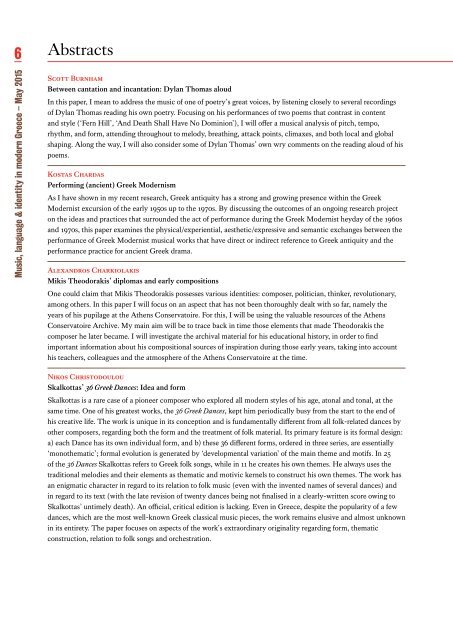Music,-language-and-identity
Music,-language-and-identity
Music,-language-and-identity
You also want an ePaper? Increase the reach of your titles
YUMPU automatically turns print PDFs into web optimized ePapers that Google loves.
6<br />
Abstracts<br />
<strong>Music</strong>, <strong>language</strong> & <strong>identity</strong> in modern Greece – May 2015<br />
Scott Burnham<br />
Between cantation <strong>and</strong> incantation: Dylan Thomas aloud<br />
In this paper, I mean to address the music of one of poetry’s great voices, by listening closely to several recordings<br />
of Dylan Thomas reading his own poetry. Focusing on his performances of two poems that contrast in content<br />
<strong>and</strong> style (‘Fern Hill’, ‘And Death Shall Have No Dominion’), I will offer a musical analysis of pitch, tempo,<br />
rhythm, <strong>and</strong> form, attending throughout to melody, breathing, attack points, climaxes, <strong>and</strong> both local <strong>and</strong> global<br />
shaping. Along the way, I will also consider some of Dylan Thomas’ own wry comments on the reading aloud of his<br />
poems.<br />
Kostas Chardas<br />
Performing (ancient) Greek Modernism<br />
As I have shown in my recent research, Greek antiquity has a strong <strong>and</strong> growing presence within the Greek<br />
Modernist excursion of the early 1950s up to the 1970s. By discussing the outcomes of an ongoing research project<br />
on the ideas <strong>and</strong> practices that surrounded the act of performance during the Greek Modernist heyday of the 1960s<br />
<strong>and</strong> 1970s, this paper examines the physical/experiential, aesthetic/expressive <strong>and</strong> semantic exchanges between the<br />
performance of Greek Modernist musical works that have direct or indirect reference to Greek antiquity <strong>and</strong> the<br />
performance practice for ancient Greek drama.<br />
Alex<strong>and</strong>ros Charkiolakis<br />
Mikis Theodorakis’ diplomas <strong>and</strong> early compositions<br />
One could claim that Mikis Theodorakis possesses various identities: composer, politician, thinker, revolutionary,<br />
among others. In this paper I will focus on an aspect that has not been thoroughly dealt with so far, namely the<br />
years of his pupilage at the Athens Conservatoire. For this, I will be using the valuable resources of the Athens<br />
Conservatoire Archive. My main aim will be to trace back in time those elements that made Theodorakis the<br />
composer he later became. I will investigate the archival material for his educational history, in order to find<br />
important information about his compositional sources of inspiration during those early years, taking into account<br />
his teachers, colleagues <strong>and</strong> the atmosphere of the Athens Conservatoire at the time.<br />
Nikos Christodoulou<br />
Skalkottas’ 36 Greek Dances: Idea <strong>and</strong> form<br />
Skalkottas is a rare case of a pioneer composer who explored all modern styles of his age, atonal <strong>and</strong> tonal, at the<br />
same time. One of his greatest works, the 36 Greek Dances, kept him periodically busy from the start to the end of<br />
his creative life. The work is unique in its conception <strong>and</strong> is fundamentally different from all folk-related dances by<br />
other composers, regarding both the form <strong>and</strong> the treatment of folk material. Its primary feature is its formal design:<br />
a) each Dance has its own individual form, <strong>and</strong> b) these 36 different forms, ordered in three series, are essentially<br />
‘monothematic’; formal evolution is generated by ‘developmental variation’ of the main theme <strong>and</strong> motifs. In 25<br />
of the 36 Dances Skalkottas refers to Greek folk songs, while in 11 he creates his own themes. He always uses the<br />
traditional melodies <strong>and</strong> their elements as thematic <strong>and</strong> motivic kernels to construct his own themes. The work has<br />
an enigmatic character in regard to its relation to folk music (even with the invented names of several dances) <strong>and</strong><br />
in regard to its text (with the late revision of twenty dances being not finalised in a clearly-written score owing to<br />
Skalkottas’ untimely death). An official, critical edition is lacking. Even in Greece, despite the popularity of a few<br />
dances, which are the most well-known Greek classical music pieces, the work remains elusive <strong>and</strong> almost unknown<br />
in its entirety. The paper focuses on aspects of the work’s extraordinary originality regarding form, thematic<br />
construction, relation to folk songs <strong>and</strong> orchestration.


